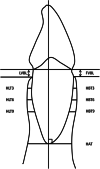Morphological changes in alveolar bone thickness and height after orthodontic proclination or labial movement combined with autogenous soft tissue grafting: a CBCT evaluation
- PMID: 37061689
- PMCID: PMC10105956
- DOI: 10.1186/s12903-023-02944-w
Morphological changes in alveolar bone thickness and height after orthodontic proclination or labial movement combined with autogenous soft tissue grafting: a CBCT evaluation
Abstract
Background: Autogenous soft tissue grafting is indicated in thin gingival biotypes before orthodontic proclination or labial movements to increase the keratinized gingiva and prevent gingival recession. However, its effect on local alveolar bone remodeling is unclear. The aim of this study was to investigate the effects of autogenous soft tissue grafting on local alveolar bone after orthodontic proclination or labial movements.
Methods: Sixteen patients with a thin scalloped gingival biotype, narrow keratinized gingiva, or thin cortical bone requiring orthodontic proclination or labial movement of teeth were included. Cone-beam computed tomography (CBCT) images were obtained before grafting and at least 6 months after surgery. Sixty mandibular teeth were included, and the vertical bone level and horizontal labial bone thickness were measured. The results were compared using paired t-tests or Wilcoxon signed-rank test.
Results: The horizontal labial bone thickness increased, especially at 6 mm below the cementoenamel junction (CEJ) in the mandibular central and lateral incisors (P < 0.05). The total alveolar bone area of the canines, first premolars, and second premolars increased at 3, 6, and 9 mm below the CEJ, respectively, and the differences were statistically significant (P < 0.05). Additionally, vertical bone height increased minimally on the labial side, but the differences were not statistically significant (P > 0.05).
Conclusions: New bone regeneration was observed on the labial (pressure) side after autogenous soft tissue grafting, which may represent a mechanism to effectively prevent gingival recession and maintain periodontal health.
Irb approval: All the experimental procedures involving humans in this study were approved by the Medical Ethics Committee of Xiangya Stomatological Hospital, Central South University ( No. 20190048).
Keywords: Autogenous soft tissue grafting; Bone regeneration; Gingival recession; Mucogingival surgery; Orthodontics; Periodontal regeneration.
© 2023. The Author(s).
Conflict of interest statement
The authors declare no competing interests.
Figures





Similar articles
-
[Clinical and radiographic effect of simultaneously labial and lingual augmented corticotomy: a prospective case series study].Zhonghua Kou Qiang Yi Xue Za Zhi. 2023 Oct 9;58(10):1010-1018. doi: 10.3760/cma.j.cn112144-20230816-00083. Zhonghua Kou Qiang Yi Xue Za Zhi. 2023. PMID: 37818536 Chinese.
-
A preliminary investigation into the impact of soft tissue augmentation-based periodontal phenotype modification therapy for patients exhibiting class III decompensation.BMC Oral Health. 2024 Aug 2;24(1):880. doi: 10.1186/s12903-024-04630-x. BMC Oral Health. 2024. PMID: 39095718 Free PMC article.
-
Augmented corticotomy combined with accelerated orthodontic forces in class III orthognathic patients: morphologic aspects of the mandibular anterior ridge with cone-beam computed tomography.J Oral Maxillofac Surg. 2013 Oct;71(10):1760.e1-9. doi: 10.1016/j.joms.2013.04.022. Epub 2013 Jun 15. J Oral Maxillofac Surg. 2013. PMID: 23773424
-
Bone Remodeling during Orthodontic Movement of Lower Incisors-Narrative Review.Int J Environ Res Public Health. 2022 Nov 15;19(22):15002. doi: 10.3390/ijerph192215002. Int J Environ Res Public Health. 2022. PMID: 36429721 Free PMC article. Review.
-
Cone-Beam Computed Tomography and Interdisciplinary Dentofacial Therapy: An American Academy of Periodontology Best Evidence Review Focusing on Risk Assessment of the Dentoalveolar Bone Changes Influenced by Tooth Movement.J Periodontol. 2017 Oct;88(10):960-977. doi: 10.1902/jop.2017.160781. J Periodontol. 2017. PMID: 28967331 Review.
Cited by
-
Influence of alveolar bone thickness and bucco-palatal inclination on root resorption of lateral incisors in unilateral maxillary impacted canines: a retrospective observational study.BMC Oral Health. 2024 Mar 2;24(1):301. doi: 10.1186/s12903-024-04076-1. BMC Oral Health. 2024. PMID: 38431628 Free PMC article.
References
-
- Anonymous. Consensus report. Mucogingival therapy. Ann Periodontol. 1996;1(1):702–6. - PubMed
Publication types
MeSH terms
LinkOut - more resources
Full Text Sources

